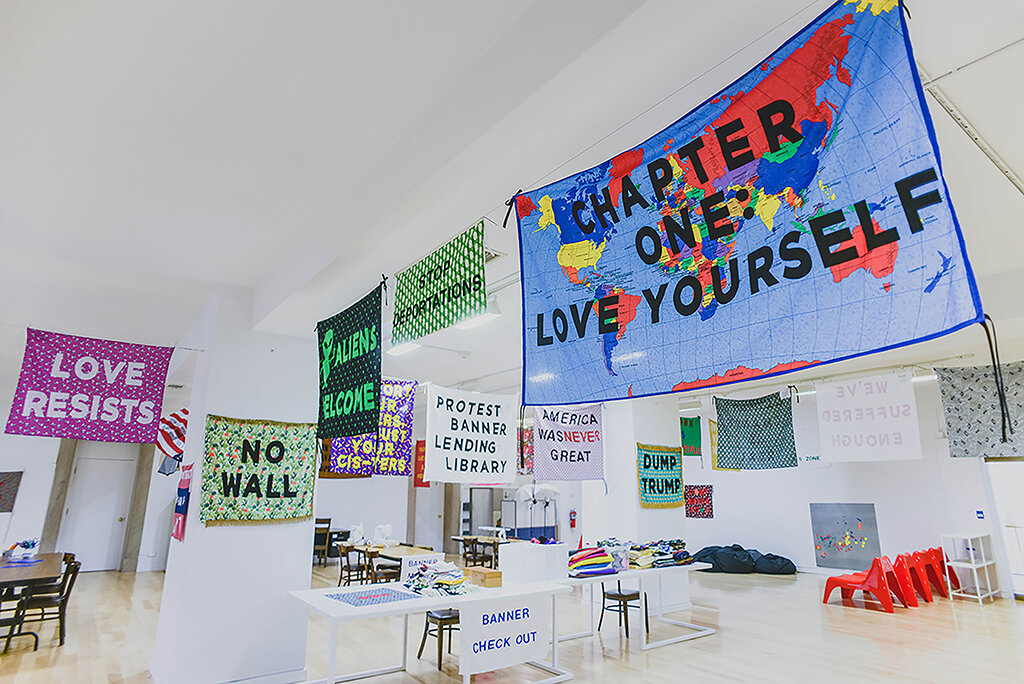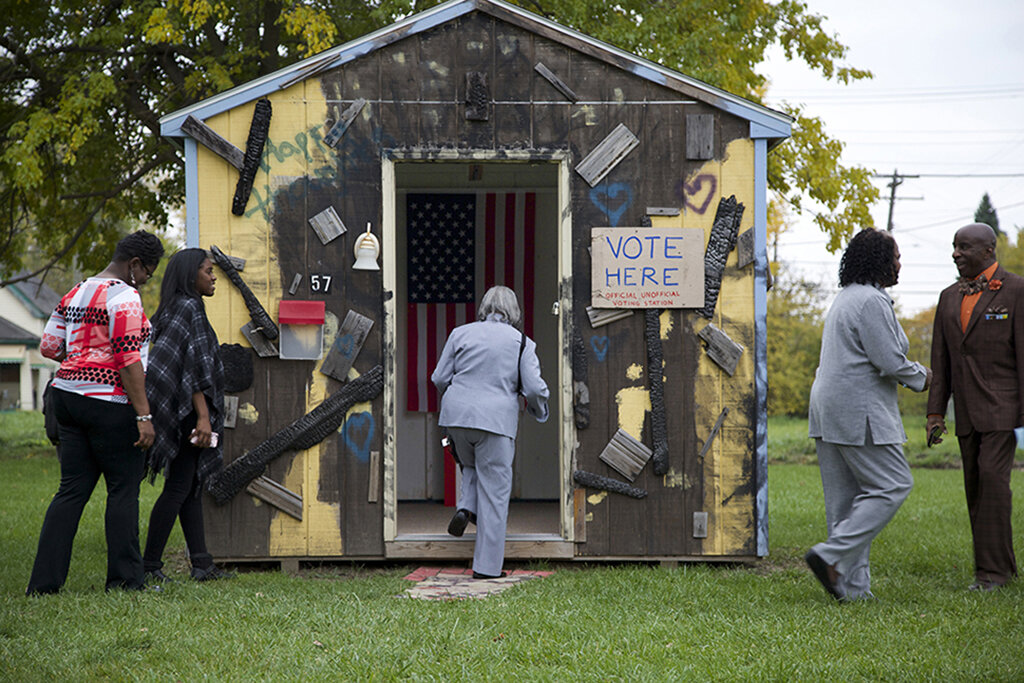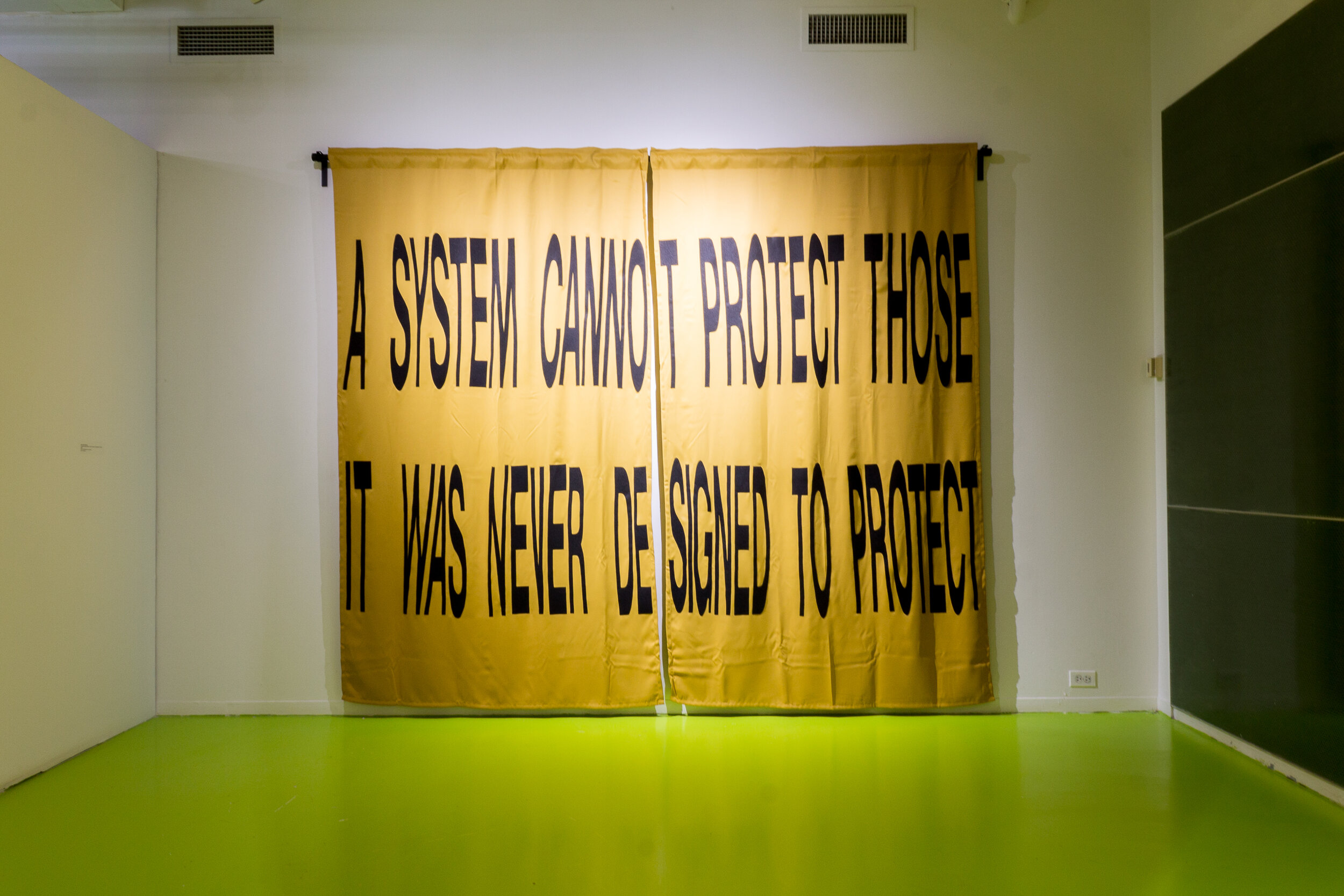Aram Han Sifuentes is a fiber and performance artist who works to claim spaces for immigrant and disenfranchised communities. Her work often revolves around skill sharing, specifically sewing techniques, to create multiethnic and intergenerational sewing circles, which become a place for empowerment, subversion and protest.
For more information, please see: https://www.aramhansifuentes.com, and on Instagram @aramhansifuentes.
Image of Aram Han Sifuentes. Photo by Virginia Harold.
First, and most importantly, how are you doing? How are you navigating the highs and lows?
Thank you for asking. Honestly, I don’t even know how to answer this question. It is such a struggle to constantly entertain a toddler at home. I have about an hour a day of uninterrupted time to work so I’m writing this in a mad fury.
Protest Banner making workshop and Protest Banner Lending Library. Photo by eedahahm.
A banner from the Protest Banner Lending Library. Image courtesy of the artist.
It's my experience that most artists engage with some level of self-isolation in their day to day art practice. Has this been your experience? And if so, have you found these innate rhythms to be helpful during this larger, world-wide experience of isolation?
I don’t do much in my art practice in self-isolation. I’m a true extrovert. I love working with people and being around people all the time. This is evident in my practice where many of my works are collaborations with other artists and my projects are participatory. At the moment, I am Chicago’s Protest Banner Lending Library so I’m still making a bunch of banners at home, communicating with banner makers and volunteers, and coordinating banner hand-offs. So, I am still not making art in isolation.
Before these protests erupted, I was negotiating two ways of making. First, I was focusing on creating textiles for voting booths for my project, Official Unofficial Voting Station: Voting for All Who Legally Can’t for the 2020 Presidential Elections. I was hand-sewing curtains for voting booths that will be on exhibit at MCA Denver in the fall and preparing for my solo exhibition at the Skirball Cultural Center in Los Angeles. So, this part of the work, I was doing in isolation (not really because my family is right next to me watching movies when I’m sewing).
Second, I am working with collaborators, and actually started new collaborations during this time. I have been working with Chicago artists to create art objects for Voting Kits for the Disenfranchised, a kit that anyone can request to create their own imaginative voting station centering those who legally can’t. With covid-19 and the need to keep social distance, I am working with artists to create a mail-in option, working with a new media artist, Jon Satrom, to create a potential virtual voting platform, and working with William Estrada to create an arts curriculum for youth around voting and disenfranchisement that will become available online.
A graphic made by Cute Rage Press (Ishita Dharap and Aram Han Sifuentes) to show who can't legally vote in the U.S. Presidential Elections.
If We Could Vote, We Would Wristbands made by Undocumented Projects.
Voting Stickers for All created by Cute Rage Press (Ishita Dharap and Aram Han Sifuentes).
It would be great if you could briefly talk us through your practice. Understanding it is integral to appreciating the multivalence of your work.
I am a fiber, social practice, and performance artist who actively engages with social issues, particularly around race politics and immigration in the United States. My work responds to the constantly changing landscape of immigration policy, and the anti-immigrant rhetoric, sentiment, and laws that gets enacted in the United States and internationally.
As an immigrant and a daughter of a seamstress, I learned to sew at age six. It was not a choice but rather a necessity to help my mother earn a living. In this way, sewing has ever since been an important part of myself, my body memory, and my politics. Sewing is my medium to investigate identity politics, immigration and immigrant labor, possession and dispossession, citizenship and belonging, dissent and protest, and race politics in the United States.
At the core of my practice, I create projects that mimic official institutions and bureaucratic processes that are inclusive of immigrants and those who are disenfranchised, rather than exclusive and oppressive. I am committed to creating change by devising spaces for my communities to speak up, celebrate, and protest. I aim to create platforms for my collaborators and participants to act (even if it is only a gesture) and be active citizens of our communities. At the core is to create interconnected gestures meant to make us visible and to push back against the oppressive systems placed upon us as racialized beings.
2016 Official Unofficial Voting Station: Voting for all Who Legally Can't. These stations were in Detroit and created by Brandon Bullard.
2016 Official Unofficial Voting Station: Voting for all Who Legally Can't. These stations were in Detroit and created by Brandon Bullard.
Has any of your imagery shifted in a reflection to what's currently happening? Or are you considering using coronavirus related imagery for future projects? Do you find it necessary to make work about the pandemic? And why, or why not?
I am needing to shift my socially engaged projects to be able to function in a society with covid-19. In addition, the City of Chicago’s Department of Cultural Affairs and Special Events recently invited me to create a covid-19 awareness billboard, led by artist Amanda Williams, that just went up this week.
I’m not necessarily making artwork about covid-19, even though I’m altering projects to fit in a society with covid, however I am making artwork about systemic racism. I always have.
A banner from the Protest Banner Lending Library. Photo by Kelly Kristin Jones.
Are you thinking differently? Coping differently? Inspired differently?
Things can’t go back to the way things were. I am angry that it took the United States so long to see how racist the system really is. I am excited that more and more conversations about systemic racism is coming to the fore. I am energized by the Black Lives Matter protests happening around the world. I want to see our cities defund police. We can’t reform violence. The only answer is to get rid of it, so I am inspired to imagine a world without police. And with all those billions of dollars that will free up from not funding police, a different world is possible. I also am hopeful that what is happening now is just the beginning. I want to see this movement continue to the defunding and abolition of I.C.E., of prisons, and everything that is here to protect whiteness and surveils, polices, exploits and kills people of color.
A banner from the Protest Banner Lending Library made by Sabba Elahi. Image courtesy of Aram Han Sifuentes
What do you think or hope will be different after this crisis has passed?
I hope people see that A SYSTEM CANNOT PROTECT THOSE IT WAS NEVER DESIGNED TO PROTECT. We have to keep fighting to create radical change. What we have now isn’t working.
In addition, I hope that the fields of textiles, crafts, art, and art education recognize how it upholds and protects white supremacy, and works hard to undo the systemic racism prevalent in art and art education.
A System Cannot Protect Those It Was Never Designed to Protect, 2018, 98 inches by 114 inches, wool felt and fusible web on household curtains. Photo credit: Jaclyn Silverman.
What is bringing you solace, or even joy, in this moment?
Joy for me in this moment is spending quality time with my family, cooking delicious Mexorean (Mexican + Korean) meals, gardening, reading, and making art.
What research or writing are you doing that you find compelling?
I’m always reading but I actually don’t have much time for it these days with an active toddler running around. We actually read a lot of books before her naptime. I particularly love reading to her writings by women of color feminists. We have been reading This Bridge Called My Back: Writings by Radical Women of Color edited by Cherríe Moraga and Gloria E. Anzaldúa and Minor Feelings: An Asian American Reckoningby Cathy Park Hong. I personally love these texts by women of color and find it so important to share at a young age with my brown and proud daughter. These texts make me feel seen, I learn so much, and I find words to my rage and pleasures through the wisdom of women of color feminists. I think it’s imperative that my child has access to this early in life. I also have a couple texts that I’m working on about my experiences as a woman of color feminist artist that will be published next year.
What are you reading?
Minor Feelings: An Asian American Reckoning by Cathy Park Hong
This Bridge Called My Back: Writings by Radical Women of Color edited by Cherríe Moraga and Gloria E. Anzaldúa











